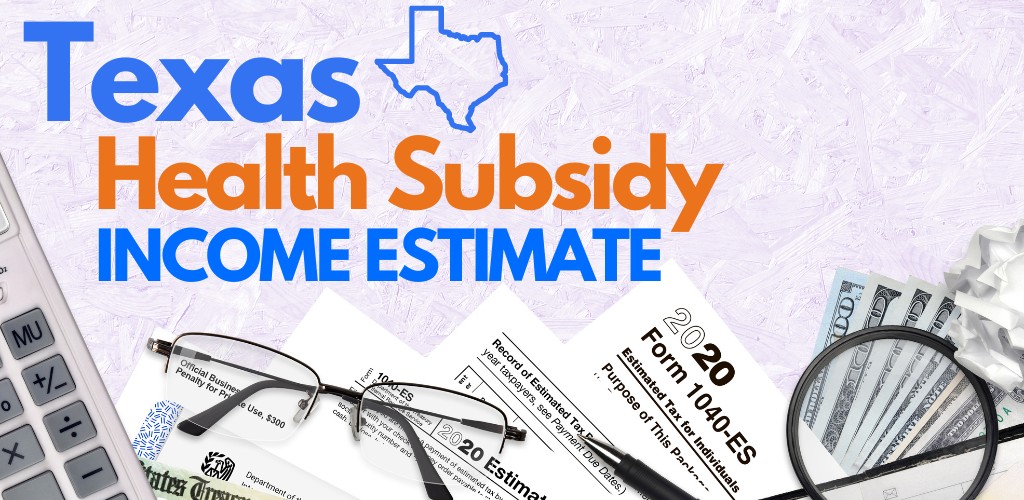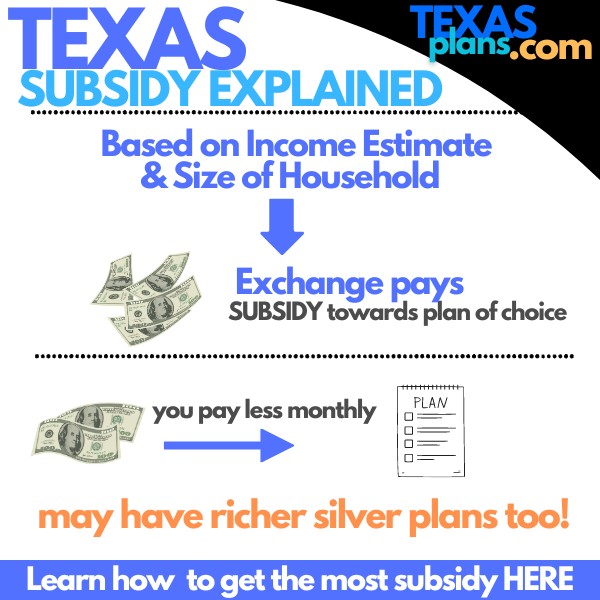
Get Help With Income Estimate for Texas Health Subsidy
We probably spend half our time on this question these days.
The income estimate is the key to subsidies which can bring down health care costs significantly!
We see premiums go down to zero sometimes and here's the rub:
Roughly 50% of people who self-enroll make mistakes which can cost them $1000's in subsidies.
Income is rarely simple these days with self-employment, rental income, gig work, etc.
Get help with this piece! To that end, here's our credentials for free assistance figuring out your income estimate for the Texas health exchange:
This is what we'll cover:
- Why the income estimate is so important to Texas Obamacare
- What income is used for Texas health subsidy
- What period of time is used for income estimate
- What qualifies as a "household" for Texas exchange tax credits
- What happens if our subsidy income estimate is wrong?
- How to quote Texas health plans based on your income estimate
We'll address 80% of the common questions below but reach out to us for the other 20% to make sure you're not leaving money on the table:
Why the income estimate is so important to Texas Obamacare
Since 2014 with the ACA law passing, the biggest thing on the health insurance scene revolves around subsidies or tax credits.
This is money that the Feds pay towards your health plan of choice which directly reduces your monthly premium.
In addition, there can even be much richer versions of the silver plan (see silver 87 and 94 health plans) if our income is within a certain range.
This begs the question. What income?
With so much at stake, we really need to get this straight! Lean on us with 10's of 1000's of ACA enrollments under our belt. We've seen it all!
Let's go through the three key points. What, When, and Who.
What income is used for Texas health subsidy
Here's the simple answer.
It's the estimate for this year's income; the AGI on the 1040 tax form the following year.
Technically, it's the MAGI. This adds a few things to the AGI:
- Foreign income
- Tax-free interest
- Untaxed social security
For most people, the AGI on the 1040 tax form takes care of the estimate. We would estimate roughly 95%+ of people can use the AGI as a good estimate.
In layman's terms, what really feeds into this AGI line on the first page of the 1040 tax form?
For W2 people, it's pretty simple. Your gross income (before taxes and other deductions).
If you make $2000/month gross (total before deductions), that's an AGI usually of $24K and this works pretty well for the Texas subsidy estimate.
Self-employed income is tougher. It's your net business income. So, gross business income for the year minus expected business expenses.
We have a whole section on self-employed and Texas Obamacare since they usually get pretty good subsidies as a result of the "net" calculation.
Rental income can be thought of as self-employment in a way since we're able to deduct expenses related to maintaining that income stream. Net income essentially.
Disability comes up often and it's trickier. SSDI is not included in our income estimate but other forms of disability income or payouts generally are.
If your income is more complicated, reach out to us and we'll walk through it in 5 minutes generally.
There's zero cost for our assistance!
You can look at your recent tax filing to get a good baseline of your AGI adjusting for what this year might bring.
That brings up the timing.
What period of time is used for income estimate
Think of it this way:
We're trying to estimate the income for the year in which we'll have the coverage.
Last year's income doesn't matter! At all.
You could have made $200K last year but if this year is expecting $50K, that's what we'll go with.
Let's give an example.
Say that you're enrolling May of 2024. It's the AGI on the 1040 tax form we'll file in April of 2025.
If we're at open enrollment in that same year and estimating for the next year, it's a full year out!
For example, it's 11/1 of 2024. We're trying to estimate for 2025 income or the AGI on the April 2026 tax filing!
See how it gets complicated fast?? Let us help you.
Just know that last year's income doesn't count and we're trying to estimate for the year we'll actually have the coverage.
We can help with this. Reach out! The next question that people get wrong quite a bit is...whose income?
What qualifies as a "household" for Texas exchange tax credits
The Texas exchange's definition of "household" is everyone that files together on that 1040 tax form in question.
Meaning, for the period we're looking at.
Even if not everyone is enrolling, they're still part of the household if on a 1040 tax form together.
What if we have people that file together but they live somewhere else (college kids, etc)?
Still part of the household!
Where things get complicated is when this makeup is changing. Marriages. Divorces. Births, etc.
With big changes, we're trying to estimate how it will all look Dec 31st of that tax year.
For example, if two people are planning to marry Sept 31st, we have to assume household of 2 by end of year (meaning how we'll file next April).
Again, this can get complicated quickly with pretty big ramifications especially if one person had much higher income than the other.
Also, to get the subsidy as a married couple, you have to file jointly! Married filing separately will not result in a subsidy!
This brings up a good question.
What happens if our subsidy income estimate is wrong?
Alright, for some people, estimating income is really difficult (think self-employed or retail)?
They probably don't know their "net" income till end of year or tax filing time at best!
What if we under or overestimate our income for the year?
It all settles out at tax time!
If we overestimated your income, you should recoup the extra subsidy you were eligible for at tax-filing time. This is a welcomed surprise.
The opposite holds true.
If we underestimated our income, we'll have to pay back the subsidy we were not eligible for at tax filing time.
There's no "penalty" per se...just paying back any extra tax credit.
You can actually adjust the subsidy you want to take monthly if you're not certain on the amount and don't want a big tax surprise.
Another key question comes up around the 100% level on the income chart (see Texas Obamacare income chart).
Below 100%, we're not eligible for a subsidy at all.
What if we estimate above that and get a huge subsidy as a result but when we actually file taxes, it turns out we're under that level.
Do we have to pay back all our subsidy when we file?
No! Technically, there's a penalty of $300 but they've never applied it since 2014 and we don't expect them to start.
It would hit the very people the law is trying to help!
If your income is around this level, reach out to us and let's really dive into it.
Any kind of change income (starting a job, losing a job, etc) can really make this thing difficult to do alone. Don't!
Our assistance is 100% free to you and we'll make sure you get the best outcome possible.
Okay, let's take the income estimate for a spin.
How to quote Texas health plans based on your income estimate
We make this free, fast, and easy here:

You'll be able to enter your income estimate and even adjust around to see what effect different possibilities might have.
Include the full number of household members even if not enrolling as it affects subsidies for those that are.
Married must file jointly to get a subsidy.
With anything more complicated (changes in income or household make-up), let's touch base!
If something is answered incorrectly on the app, it might show no subsidy or not enough (or even too much).
We have a simplified online app here which we scrub and can catch issues when enrolling. It's much easier to address these questions before rather than trying to fix them after.
Again, we're happy to help with any questions!
Learn more about how to get the most Texas health subsidy
Income chart for Texas Obamacare
